Plant Phyla

The many species of organisms in the plant kingdom are divided into several phyla, or divisions, totaling about 260,000 species. The bryophytes are a diverse assemblage of three phyla of nonvascular plants, with about 16,000 species, that includes the mosses, liverworts, and hornworts. Bryophytes lack a well-developed vascular system for the internal conduction of water and nutrients and have been called nonvascular plants. It takes two generations to complete the plant life cycle (Alternation of Generations). The familiar leafy plant of bryophytes is the sexual, or gamete-producing, generation of the life cycle of these organisms. Because of the lack of a vascular system and because the gametes require a film of water for dispersal, bryophytes are generally small plants that tend to occur in moist conditions, although some attain large size under favorable circumstances and others (usually very small) are adapted to desert life.
The other phyla are collectively termed vascular plants, or tracheophytes. Vascular tissue is internal conducting tissue for the movement of water, minerals, and food. There are two types of vascular tissue: xylem, which conducts water and minerals from the ground to stems and leaves, and phloem, which conducts food produced in the leaves to the stems, roots, and storage and reproductive organs. Besides the presence of vascular tissue, tracheophytes contrast with bryophytes in that tracheophyte leafy plants are the asexual, or spore-producing, generation of their life cycle. In the evolution of tracheophytes, the spore-producing generation became much larger and more complex, whereas the gamete-producing generation became reduced and merely contained in the sporophyte tissue. This ability to evolve into larger and more diverse sporophytes, together with the ability of the vascular system to elevate water, freed tracheophytes from direct dependence on surface water. They were thus able to dominate all the terrestrial habitats of the Earth, except the higher Arctic zones, and to provide food and shelter for its diverse animal inhabitants.
The other phyla are collectively termed vascular plants, or tracheophytes. Vascular tissue is internal conducting tissue for the movement of water, minerals, and food. There are two types of vascular tissue: xylem, which conducts water and minerals from the ground to stems and leaves, and phloem, which conducts food produced in the leaves to the stems, roots, and storage and reproductive organs. Besides the presence of vascular tissue, tracheophytes contrast with bryophytes in that tracheophyte leafy plants are the asexual, or spore-producing, generation of their life cycle. In the evolution of tracheophytes, the spore-producing generation became much larger and more complex, whereas the gamete-producing generation became reduced and merely contained in the sporophyte tissue. This ability to evolve into larger and more diverse sporophytes, together with the ability of the vascular system to elevate water, freed tracheophytes from direct dependence on surface water. They were thus able to dominate all the terrestrial habitats of the Earth, except the higher Arctic zones, and to provide food and shelter for its diverse animal inhabitants.



Comments